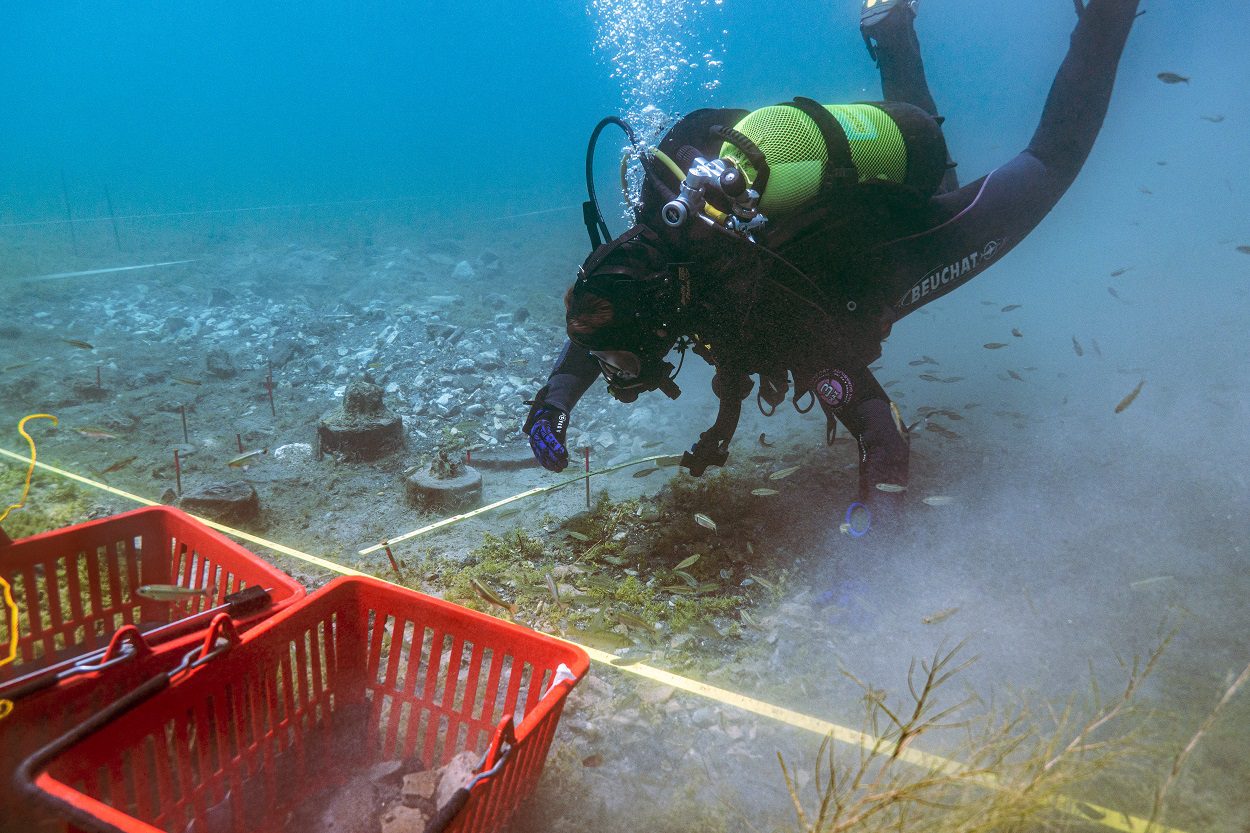A research team from the University of Bern has managed to precisely date pile dwellings on the banks of Lake Ohrid in the south-western Balkans for the first time: they came into being in the middle of the 5th millennium BC. The region around the oldest lake in Europe played a key role in the proliferation of agriculture.
Remains of under-water sites are a stroke of luck for pre-historic archaeology. The wooden piles from which their foundations were built have been preserved excellently: In the absence of oxygen, they were not corroded by bacteria or fungi. Wood preserved in this way is excellently well suited for dendrochronological examinations, which can be dated using growth rings.
The age of the wood, and thus the time at which the settlements were built, can be determined in combination with radiocarbon dating. This method has now been applied outside of the Alpine region for the first time.
Under the leadership of the University of Bern, around 800 piles were dated in the large international EXPLO project (see info box). They come from a site on the east coast of Lake Ohrid.
The new findings prove that the settlement in the Bay of Ploča Mičov Grad near the Macedonian town of Ohrid was constructed in different phases. And over thousands of years: From the Neolithic Period (middle of the 5thmillennium BC) until the Bronze Age (2nd millennium BC).
Until now, it was assumed that it was a settlement from the period around 1000 BC. This intensive construction activity explains the extraordinary density of wooden piles at the site. The settlements were built virtually over one another.
The cradle of European agriculture
“The precise dates of the different settlement phases of Ploča Mičov Grad represent important temporal reference points for a chronology of prehistory in the south-western Balkans, “says Albert Hafner. He is Professor of Prehistoric Archaeology at the University of Bern and a member of the Oeschger Center for Climate Change Research. The precise chronological classification, in turn, opened up unimagined possibilities of interpretation for the traces found of the early occupation of Lake Ohrid.
A so-called cultural layer is hidden under the present-day lakebed. It consists mainly of organic material and is up to 1.7 meters thick. Among other things, it contains the remains of harvested grain, wild plants and animals, which can provide conclusions on the development of agriculture.
In the Balkans, the newly arrived farmers were confronted with comparatively cool and humid climate conditions, which forced them to adapt agricultural practices accordingly. “The interactions between this revolutionary innovation and the environment are largely unknown, “emphasized Hafner. This is precisely the research gap that the EXPLO project aims to fill.
The pile dwellings in the Alpine region and the archaeological site in the Balkans are the only remains of settlements from the Neolithic Period with excellent organic conservation. The early findings are particularly interesting as the area played a key role in the proliferation of agriculture: Europe’s first farmers lived here. Early cattle breeders and arable farmers from Anatolia first reached the Aegean region, especially northern Greece, and then Central Europe via southern Italy and the Balkans more than 8,000 years ago.
Important cultural heritage in the Balkans
“Our investigations are shining a light on the large potential for future research on the pre-historic settlements in the region,” says Hafner. The significance of the settlements on Lake Ohrid is huge: “The pile dwellings around the Alps have been considered a UNESCO World Heritage Site since 2011, and the wetland settlements in the south-western Balkans are no less significant, “said Albert Hafner.
The region offers a situation comparable to the area around the Alps: Relics of prehistoric settlements have been preserved in numerous lakes in modern Albania, northern Greece and North Macedonia. However, with few exceptions, the sites in the Balkan region have hardly been studied so far.
Bern researchers are also pursuing other goals over the long term. “We want to help ensure that the value of these wetland settlements is recognized locally and that these cultural assets are better protected, “explained Hafner. Sites are not only located on the north Macedonian shore of Lake Ohrid, where the EXPLO team conducted fieldwork campaigns in 2018 and 2019, but also on the Albanian western shore of the lake, where the researchers were active this summer at the Lin 3 site. In the long term, it is planned to expand collaboration with local partners, support the education and training of researchers from the region and promote local initiatives.
Header Image Credit : Marco Hostettler





